Abstract
Central to the issue faced by many developing countries around the world today is sustainable development. Creating a sustainable environment has become the main focus in many countries, including Malaysia. The issue of cleaning the environment using standard refuse management system costs a considerable amount of money. Even with a tremendous amount of money spent to clean the environment, there is no guarantee that the condition can be sustained shortly. For an urban area like Kuala Lumpur, the problem has worsened due to the rapid growth of population and other development that make the refuse management system hard to sustain. Although many mechanisms have been suggested to keep the environment clean and sustainable, the problem seems hard to solve without the full engagement of the surrounding community and technology. Only with smart city initiatives through technology integration in a refuse management system can the environment be kept clean anytime anywhere. Thus, main objectives of the paper are to look at the smart partnership integration between technology and community that can be implemented to reduce the problems faced in managing a clean environment especially in an urban area where the problem is critical.
Keywords: Sustainable environmentsmart citiessmart appsintelligent appscommunity engagement
Introduction
Swift population growth and hasty urbanisation phenomena in many countries have created new challenges in waste management. It is expected that the annual waste generation will increase by 70% and this amounted to 3.40 billion tonnes in 2050 (World Bank Development Report, 2018). These rapid changes are having a severe effect on waste management since the cost is often expensive and takes up between 20% –50% of municipal budgets. A report from the Malaysian Department of Environment (2018) revealed that every year, the government spends as much as RM60 billion to clean rivers and the surrounding environment. Despite the great money spent to clean the environment and the surrounding, there is an increasing concern that Malaysian environment today will face a higher degree of degradation leading to the destruction of the supporting ecosystem due to significant pollution. This issue has caused a considerable challenge in formulating a holistic and sustainable environment management plan as most of the urban environments are prone to high pollution. Therefore, it has become the primary intention of this paper to examine the possibilities of the integration of technology through the application of smart apps that can help in the reduction of pollution in the surrounding area and the surrounding ecosystem especially in the city centre where the population density is high.
The Smart City Concept
The concept of smart cities has started to become the central attention of many researchers who are working on the solution to solve the problem that exists in the city centre. Added with the current phenomenon of spectacular growth around the world, the emergence of these concept has become the primary attention. Harrison et al. (2010) defined a smart city as a means of ICT, social business and infrastructures. Many researchers believe that maintaining a city operation with the aid of ICT could make cities more efficient in various aspects (Silva et al., 2018). In urbanised world, these concepts are usually seen as tools to explain most of the inner-city trials (Albino et al., 2015).
To implement the system, numerous components are differently highlighted and practically essential to note. In discussing smart city concept, all the researchers in this area previously concluded that the system of smart city should include the elements of the human quality of life, information technologies, new government, and support innovation that can reach to a more sustainable territory (Desdemoustier et al., 2019).It is indeed an undoubtedly a favoured concept in any urban model planning (Mohanty et al., 2016). Many of the application discussed in IoT was inherited in the underlying operational mechanism of IoT. Fig. 01 shows the vital smart cities components, which include smart cities, data generation, data management and application handling. Thus, this study looks into a similar area of the application of intelligent apps in maintaining the sustainability of the environment.
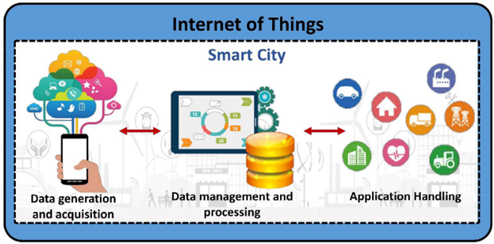
Although there are several arguments on the application of the smart city concept in the urban area, still all of the past studies nevertheless agree on the utilisation of the network infrastructures to improved economic and political efficiency and thus contribute to the urban sustainability (Hollands, 2008). However, no single study exists which explains in detail how this smart app could be integrated with smart cities initiatives as a useful tool to achieve sustainable development. Moreover, there is still a lack of community engagement discussion from Malaysian empirical evidence. Thus, Dameri (2013) highlighted that there is an urgent need to develop the right approach to implement this concept in the city centre where the problem of pollution and maintaining the environment is critical. This study tries to fill up the gap by looking into how smart apps could be used as a tool in a smart city in managing the environment through the community engagement and waste management from the perspective of Malaysian empirical evidence.
Usage of technology in performing Smart City
In recent advancement, the emergence of connecting a smart device with an everyday object has become highly favourable (Silva et al., 2018). Mobile phones, on the other hand, are the leading technology most commonly used for effective information dissemination either through push notifications (Tan et al., 2016) or traditional notifications that have been effectively used for community alerts (Toda et al., 2016). A recent study by Saffuan et al. (2018) claimed that the application and design approach using green technology is seen as a new solution to reduce the current pollution issues.
Silva et al. (2018) had highlighted that there are three main important attributes to form a smart city concept which include attributes, themes and infrastructures (Refer Fig 02).
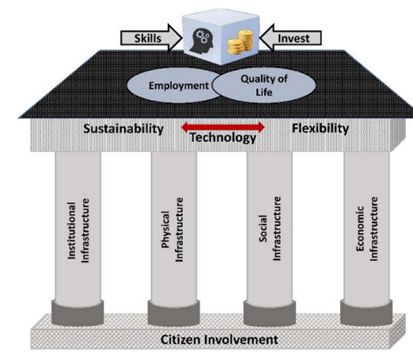
From Fig.
Engagement of smart community and Smart City
In proper waste behaviour, it is expected that consumer behaviour could contribute to a critical role. This is because effective waste management heavily depends on the lifestyle of the citizen. (Esmaeilian et al., 2018). Apart from that, Silva et al. (2018) also pointed out that smart integration also increases the satisfaction and well-being of the citizen. Moreover, their research also reported that the standalone components could not underwrite to the successfulness of the smart city performance in city centre. Hence, they believed that an intelligent community is much needed to stay linked several components to maximise the assistance of the concept of smart city, especially when cleaning the environment is a concern. To achieve an optimum performance, further integration with smart appliances, sensors and software are much needed. This is because when it comes to energy management, smart building and other initiatives share a common motive. This will then lead to little energy ingesting and reducing the phenomenon of carbon footprint (Eichholtz et al., 2010).
Studies have shown that virtual rewards which use rank-based systems to indicate members' status can be engaging as reputation-conscious members of the community are highly motivated by that (Mutter, 2014). Similar research into the reward system of a crowdsourcing application also found that virtual rewards such badges and progress tracking enhances user enjoyment in the behavioural emotional and cognitive context (Goh et al., 2017). These studies have shown that community engagement is possible and that a suitable reward system can encourage sufficient community participation. Recent research conducted by Sasao et al. (2017) has shown that reminders can broaden participation in local communities. This particular research also provided evidence that involving the community offers many benefits that contribute to the success of a specific project as a whole. The goal of building community awareness is to increase the community’s knowledge of the current state of trash in the river and how they can help to reduce it. This can be accomplished by disseminating information to the general public using various media, including ticker boards and mobile phones. It is agreed that both devices like phone and board have been successfully used for disseminating information in other applications due to their advantages when compared to other digital displays such as economic cost, flexible size, simple to control (no dedicated computer needed), and seamless, smooth scrolling (Sain et al., 2017). Mobile phones, on the other hand, are the leading technology most commonly used for effective information dissemination either through push notifications (Tan et al., 2016) or traditional notifications that have been effectively used for community alerts (Toda et al., 2016). A recent study by Saffuan et al. (2018) agreed that the application and design approach using green technology is a novel resolution that could reserve landscape and swiftly diminish the pollution.
Sustainable environment
Past research conducted by Ahvenniemi et al. (2017) further explore some differences of a smart cities concept and sustainable cities. They found that the framework of sustainable cities is not enough to support the sustainability-related indicators, particularly on environmental issues such as energy and waste. Furthermore, they have also highlighted that water management is also still underrepresented. It is believed that if the water management issues are not solved, this will lead to further environmental degradation issues Kirkman and Voulvoulis (2017).
Although several studies did focus on the waste management topic, the integration of IoT enables based on waste is still new. Glouache and Couderc (2013) had focus on data acquisition and sensor technology waste management, while Medvedev et al. (2015) had concentrate on the development of communication technologies and data transmission. Another study done by Gutierrez et al. (2015) had focus on the capabilities of IoT system in field experiments while Anagnostopoulos et al. (2015) focus on trucking, route and schedule for a waste collection operation.
A recent study by Esmaeilian et al. (2018) had concluded that to solve the waste management problem in the city centre, a new form of waste collection and treatment is much needed. They have also highlighted that in the transition to becoming a sustainable city, three strategies were highlighted which include waste prevention, waste collection and value recovery from waste collection. Therefore, this study intends to look at it from the same perspective.
Problem Statement
It is believed that the highest quality of urban life could be achieved framework smart city initiatives (Kummitha & Crutzen, 2017). Added with the problem of rapid environmental degradation while moving towards the greater urbanisation process, the issue has become crucial and need to be tackled (Rasidi et al., 2018). There are two powerful tactics to talk about smart cities which is the technology-driven method (TDM) and the human-driven method (HDM) (Letaifa, 2015). The problem has, therefore worsened due to failure to understand the success factors of smart city implementation especially in engaging the community to be part of the system. To date, there has been little agreement on the method by which society as a whole can get involved in reducing environmental pollution. Apart from that, it was found that only a few looks at the application of smart apps as a new method in engaging the community to free the surrounding environment from pollution. Thus, this study attempts to look at how intelligent apps could be utilised to achieve a sustainable environment through proper community engagement.
Research Questions
Following is the research question for the study.
What is the ideal model needed to form a basic structure for smart apps development in tackling the issue of environmental sustainability?
How to use this model to synthesise community engagement in smart cities with regards to sustainable environmental planning?
An ideal model of technology implementation should engage with a full corporation of the community. Among the suggested models of technology used to get full engagement is the apps which are considered as the cheapest form of integration and easily accessed by most in the community. Thus, this study focuses on a few critical variables in developing the apps based on the suggested theoretical framework which integrates a sensor, alert system, community and authority engagement towards achieving a sustainable environment planning (refer Fig 03). The second part of the research question tests on the functionality of the apps through the application on actual site, to test the ability to send in data and capture a full engagement of the community in cleaning the environment and subsequently achieve the sustainable environment.
Purpose of the Study
Following is the purpose of the study:
To develop a conceptual model that is capable of displaying a basic structure needed for smart apps development in tackling environmental sustainability issues.
To create community engagement in Smart City initiatives with regards to sustainable environmental planning by using this model.
Research Methods
The primary methodology of the study starts with the survey and interviews with different groups of key stakeholders which includes government, private companies, universities and research centres. Then the conceptual model was established from the discussion with various stakeholders. This method was adopted from Fernandez-Anez et al. (2018), who did a similar study in an urban area. However, this paper only reports on the second phase of the survey, which only touches on the analysis of the smart app component being developed to tackle the issue of pollution in the surrounding environment. In this study two main tools focusing on that is the sensor and the apps as the primary device to connect the community in cleaning up the environment. A thorough investigation of the development of the app was considered where each feature was carefully examined to perform a smart partnership with the surrounding community. For the pilot testing, only one recycling bin was selected. The recycle bins chosen were located in Kuala Lumpur. Other types of a container were excluded. The second phase of the methodology lies in the testing of the device under the real condition and the functionality of the equipment on-site. The bins selected were installed with the sensor that will send the data through the apps being developed. The installation of the apps was done manually to test the reliability of the data transmitted, especially when the bin is full or empty. The result was carefully examined to maintain the accuracy level of the information sent to the apps through users’ mobile phone. The function of the 24-hour monitoring system was thoroughly carried out in ensuring the effectiveness of the usage of the smart app among the community and other stakeholders.
Findings
This section discusses the second phase of the study, which focuses on the smart app's analysis.
Main system component as smart initiatives
After a thorough investigation on the device needed to engage the community with the effort to clean the environment and achieve a sustainable environment, the research found that several items need to be integrated as a smart city initiative. The study highlighted that to produce intelligent apps that could engage the community; three main components are required together in obtaining a green and sustainable environment (refer to Fig03). These include a sensor, alert system, community and mobile apps as a tool that should be used as the main framework.
The usage of smart sensors which are connected to the respective recycling bin will act as a monitoring device to control and clean the environment where 24 hours monitoring system is available. The smart sensor will then send information to the apps and alert the community on the current status of the trash. By doing that, the intelligent community is given a chance to engage in cleaning up the environment, especially in the areas nearby them. For testing purposes, the small-scale implementation was built and attached to the current recycle trash bin. The smart sensor was used to indicate that it was time to collect the trash according to the respective bin which is placed around the residential area or city centre. The only indication or sign given to collect the waste was “the percentage capacity” (refer Fig 04.). The collected data were then used to send an alert notification through an alert system to ‘hail’ the user to collect the trash at the specific location.
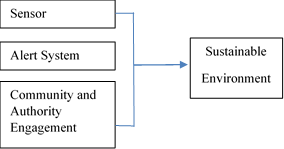
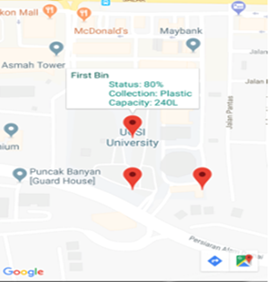
With the integration of the three elements, the location of the recycling item could be easily detected by all stakeholders, especially the vendors and public who want to make extra cash. Wastage on fuel, time and energy for a standard procedure of collecting recyclable items using lorry in the residential area could be reduced. The function of locating the bin can direct them straight to the bin and reduce the travelling expenses and carbon emission. Not only that, but the consumers also could get the information on which bin is still available for them to throw their rubbish correctly so that the environment could be kept clean. The problem of an uncertain hour of recycle bin collection system will be solved in most of the residential areas practising trash separation or sorting.
Getting started and the novelty of the smart apps
This app can easily be downloaded for free, and the registration can be completed by following the four simple steps, as shown in Fig 05. Normal registration is needed for the activation of the smart apps. The smart apps are similar to any other apps used, but the main novelty criteria of the apps are the community engagement together with authority. The system design is friendly to all age groups that even a small child can use it.
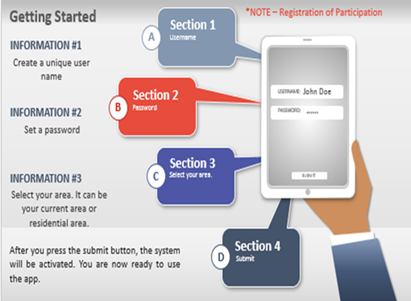
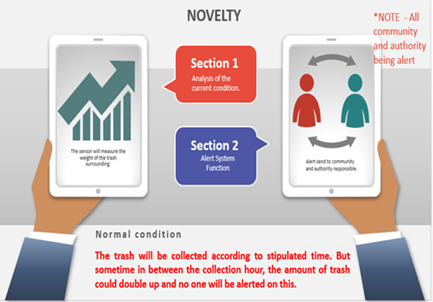
Figure
Conclusion
Concerning a recommendation for future work, this app should be expanded and deployed worldwide as the central tool for facilitating in the cleaning up of the environment where there is a 24-hour monitoring system. It should also not be limited to applications for the land trash cleaning but in the river as well. The app is easy to use, and the usage is free of charge. With these features, it is hoped that all community members will get engaged in cleaning up the environment together for a better and sustainable environment. This research also contributes to the theory of technology integration as the primary tool in developing a sustainable environment. Besides, a practical way of using the apps to clean the situation could also be achieved through the full implementation of apps which is free and easy to be used by all society. Thus, it can be concluded that by using the smart city initiatives tools:
The level of pollution will reduce
The level of pollution in the surrounding areas could be reduced at the lowest possible cost. With a 24-hour monitoring system, the sensor will update the latest status of the trash anytime, anywhere with the lowest possible price. Thus, the trash level can be easily monitored especially during festive season where the amount of trash will grow triple in a short period. As the usage of the app is free, managing the environment is at the lowest possible cost for everyone.
Community engagement will increase
Besides being able to reduce the pollution level at the lowest possible cost, the total overall community engagement is expected to increase with the smart app usage. This is because the app is easy to install at no cost at all. By using this smart app as a smart city initiative towards achieving a sustainable environment, now everyone in the society can participate in cleaning up the environment together. This will reduce the burden of authority in the effort to clean the environment.
Generate economic income
Moreover, the usage of this app could also generate economic income among the lower-income group or the current recycle practitioner where trash could be converted into cash anytime. This is due to easy and fast monitoring of recyclable trash through the mobile app installation. All recycle bins could be easily located and collected at any convenient time. To any individuals who need money, this would be a good platform.
Achieved a sustainable environment
The usage of the smart initiative tool would increase the chances of achieving the sustainable environment in the most natural way as normal trash collection procedure fails to practice an environmental friendly trash collection, especially on the recyclable items. In a standard procedure, a lorry operated by individual operator will make a trip from one residential area to another residential area, consuming a lot of time and releasing a lot of carbon monoxide but end up not meeting their objective to collect the trash because everything is unknown. With the current smart apps, the unnecessary trip can be cut, and this saves a lot of time, fuel consumption, and burning process that will harm the environment. This is because they will now make the trip to the exact location with full trash bin only.
References
- Ahvenniemi, H., Huovila, A., Pinto-Seppä, I., Airaksinen, M. (2017). What are the differences between sustainable and smart cities? Cities, 60, 234– 245.
- Albino, V., Berardi, U., & Dangelico, R. M. (2015). Smart cities: Definitions, dimensions, performance, and initiatives. Journal of Urban Technology, 22(1), 3–21.
- Anagnostopoulos, T., Zaslavsky, A., & Medvedev, A. (2015). Robust Waste Collection Exploiting Cost Efficiency of IoT Potentiality in Smart Cities. In 2015 International Conference On Recent Advances in Internet of Things (RIoT) (pp. 1-6). https://doi.org/10.1109/RIOT.2015.7104901
- Dameri, R. P. (2013). Searching for Smart City definition: A Comprehensive Proposal. International Journal of Computers & Technology, 11(5), 2544–2551.
- Desdemoustier, J., Crutzen, N., Cools, M., & Teller, J. (2019). Smart City appropriation by local actors: An instrument in the making. Cities, 92(January), 175–186.
- Eichholtz, P., Kok, N., & Quigley, J. M. (2010). Doing well by doing good? Green office buildings. The American Economic Review, 100, 2492–2509.
- Esmaeilian, B., Wang, B., Lewis, K., Duarte, F., Ratti, C., & Behdad, S. (2018). The future of waste management in smart and sustainable cities: A review and concept paper. Waste Management, 81, 177–195.
- Fernandez-Anez, V., Fernández-Güell, J. M., & Giffinger, R. (2018). Smart City implementation and discourses: An integrated conceptual model. The case of Vienna. Cities, 78(November 2017), 4–16.
- Goh, D. H., Pe-Than, E. P., & Lee, C. S. (2017). Perceptions of virtual reward systems in crowdsourcing games. Computers in Human Behavior, 70, 365-374.
- Glouache, Y., & Couderc, P. (2013). A Smart Waste Management with Self- Describing Objects. The Second International Conference on Smart Systems, Devices and Technologies (SMART'13), IARIA, Jun 2013, Rome, Italy.
- Gutierrez, J. M., Jensen M., Henius M., Riaz, T. 2015. Smart waste collection system based on location intelligence. Procedia Computer Science, 61, 120–127.
- Harrison, C., Eckman, B., Hamilton, R., Hartswick, P., Kalagnanam, J., Paraszczak, J. Williams,P.(2010). Foundations for smarter cities. IBM Journal of Research and Development, 54, 1–16.
- Hollands, R. G. (2008). Will the real smart city please stand up? Intelligent, progressive or entrepreneurial? City, 12, 303–320.
- Kummitha, R. K. R., & Crutzen, N. (2017). How do we understand smart cities? An evolutionary perspective. Cities, 67, 43–52.
- Kirkman, R., & Voulvoulis, N. (2017). The role of public communication in decision making for waste management infrastructure. Journal of Environmental Management, 203, 640–647.
- Letaifa, S. B. (2015). How to strategize smart cities: Revealing the SMART model. Journal of Business Research, 68(7), 1414–1419.
- Malaysian Department of Environment. (2018). Environment Quality (Clean Air) Regulation 2014- Environmental Quality Act 1974. Department of Environment, Ministry of Energy, Technology, Science, Environment & Climate Change.
- Medvedev, A., Fedchenkov, P., Zaslavsky, A., Anagnostopoulos, T., Khoruzhnikov, S. (2015). Waste Management as an IoT- Enabled Service in Smart Cities. In Conference on Smart Spaces (pp. 104-115). Springer.
- Mohanty, S. P., Choppali, U., & Kougianos, E. (2016). Everything you wanted to know about smart cities: The internet of things is the backbone. IEEE Consumer Electronics entrepreneurial? City, 12, 303–320.
- Mutter, T. (2014). Don’t take away my status! – Evidence from the restructuring of a virtual reward system. Computer Networks, 75, 477-490.
- Rasidi, M. H., Jamirsah, N., & Said, I. (2018). Development of Urban Green Space Affects Neighbourhood Community Social Interaction. Asian Journal of Environment Behaviour Studies, 3(80),71-88.
- Saffuan, R., Ariffin, J., & Amin, Z., (2018).Green Technology Design Approach for Liveable Park of Tasik Biru Kundang, Malaysian. Asian Journal of Environment-Behaviour Studies, 3(7), 91.
- Sain, V., Kundu K.K., & Mehta, V.P. (2017). Dissemination and Utilization of Market Information System by Farmers for Gram Crop in Bhiwani District of Haryana, India. International Journal Current Microbiology Application Science, 6(4), 58-65.
- Sasao, T. K., Kostakos, V., Kuribayashi, K., & Goncalves, J. (2017). Community Reminder: Participatory contextual reminder environments for local communities. International Journal of Human-Computer Studies, 102, 41-53.
- Silva, B. N., Khan, M., & Han, K. (2018). Towards sustainable smart cities: A review of trends, architectures, components, and open challenges in smart cities. Sustainable Cities and Society, 38(February), 697–713. https://doi.org/10.1016/j.scs.2018.01.053
- Tan, L., Roegiest, A., Lin, J., & Clarke, C. L. (2016). An exploration of evaluation metrics for mobile push notifications. In Proceedings of the 39th International ACM SIGIR conference on Research and Development in Information Retrieval (pp. 741-744).
- Toda, M., Njeru, I., Zurovac, D., Tipo, S. O., Kareko, D., Mwau, M., & Morita, K. (2016). Effectiveness of a mobile short-message-service–based disease outbreak alert system in Kenya. Emerging infectious diseases, 22(4), 711.
- World Bank Development Report (2018). Reducing Pollution. The World Bank Group.
Copyright information

This work is licensed under a Creative Commons Attribution-NonCommercial-NoDerivatives 4.0 International License.
About this article
Publication Date
06 October 2020
Article Doi
eBook ISBN
978-1-80296-087-7
Publisher
European Publisher
Volume
88
Print ISBN (optional)
-
Edition Number
1st Edition
Pages
1-1099
Subjects
Finance, business, innovation, entrepreneurship, sustainability, environment, green business, environmental issues
Cite this article as:
Sham, R., Lim, E. W. L., Othman, R., Rasi, R. Z., & Mohamad, N. M. N. (2020). Smart City Initiatives For Sustainable Environmental Planning. In Z. Ahmad (Ed.), Progressing Beyond and Better: Leading Businesses for a Sustainable Future, vol 88. European Proceedings of Social and Behavioural Sciences (pp. 992-1002). European Publisher. https://doi.org/10.15405/epsbs.2020.10.92
